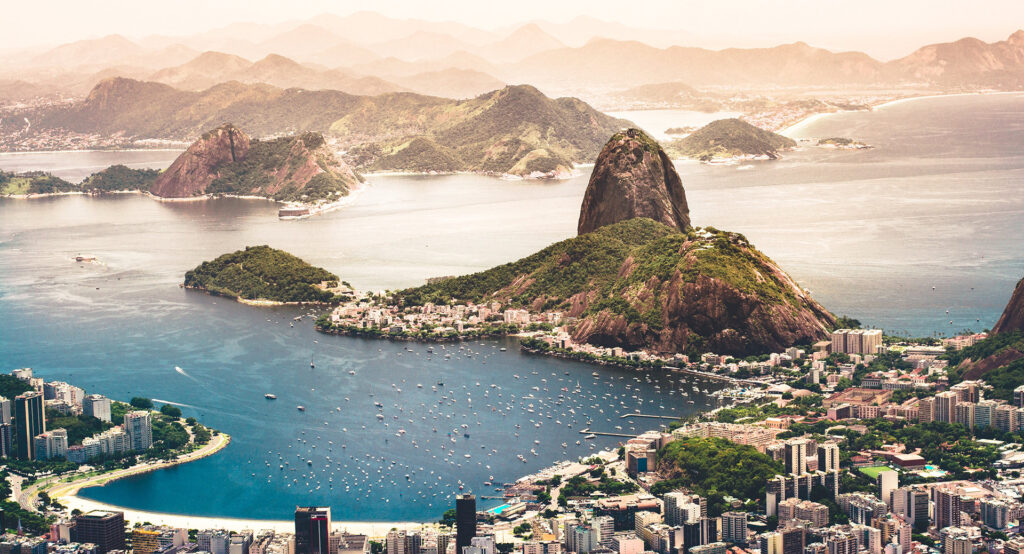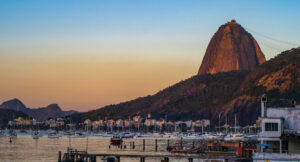19 Facts About Harbor of Rio de Janeiro, Brazil
The harbor of Rio de Janeiro, Brazil, is one of the most beautiful and iconic harbors in the world. Here are some interesting facts about the harbor:

The harbor of Rio de Janeiro is located on the south-eastern coast of Brazil.
1 In the state of Rio de Janeiro. It is situated on the western shore of Guanabara Bay, which is an estuary that connects to the Atlantic Ocean. and is considered one of the most beautiful natural harbors in the world.
The entrance to the harbor of Rio de Janeiro is approximately 1.5 miles wide.
2 Making it one of the largest natural harbor entrances in the world. The entrance is guarded by two large fortresses: Fort Santa Cruz and Fort São João, which were built in the 16th and 17th centuries to protect the harbor from enemy attacks.
The entrance to the harbor is also marked by several iconic landmarks, including Sugarloaf Mountain and the Corcovado Mountain, which is home to the famous Christ the Redeemer statue.
The harbor is surrounded by several hills.
3 Including Sugarloaf Mountain, which is one of the most iconic landmarks of Rio de Janeiro.
Other hills that surround the harbor include Corcovado Mountain, which is home to the Christ the Redeemer statue, and the Tijuca Massif, which is a large forested mountain range that contains the Tijuca National Park.
These hills provide a beautiful backdrop to the harbor and add to its natural beauty.
The harbor of Rio de Janeiro has a long history that dates back to the early 16th century.
4 When it was discovered by Portuguese explorers who were sailing along the Brazilian coast.
The first European to enter the harbor was the Portuguese explorer Gaspar de Lemos, who arrived in January 1502 and named the bay “Rio de Janeiro” (which means “January River” in Portuguese) because he mistakenly believed that the bay was the mouth of a large river.
The harbor soon became an important trading center for gold, diamonds, and other precious commodities, and was later used as a naval base by the Portuguese and Brazilian Navies.
Today, the harbor is still an important centre for trade and commerce, as well as a popular tourist destination.
During the 17th and 18th centuries, the harbor of Rio de Janeiro became an important centre for trade and commerce.
5 Particularly for the export of gold, diamonds, and other precious commodities.
Brazil was a colony of Portugal at the time, and Rio de Janeiro was the capital of the colony. The harbor played a crucial role in the transportation of goods to and from Europe, Africa, and other parts of the Americas, and helped to make Brazil one of the wealthiest colonies in the world.
The harbor also served as a port of call for many European ships, which stopped in Rio de Janeiro to resupply and repair their vessels on their way to and from other parts of the world.
The harbor of Rio de Janeiro was used as a naval base by the Portuguese Navy during the colonial period of Brazil.
6 The Portuguese used the harbor as a strategic location to protect their interests in Brazil, and to defend against attacks from other European powers.
They built several fortresses and naval bases along the harbor, including the Forte de Copacabana and the Forte de São João, which still stand today and serve as popular tourist attractions.
The harbor was also an important location for the Brazilian Navy after Brazil gained its independence from Portugal in 1822. The Brazilian Navy continues to use the harbor as a base to this day.
In the early 20th century, the harbor of Rio de Janeiro underwent a major modernization.
7 Major modernization and expansion process to accommodate the growing needs of trade and commerce.
The process began in the late 19th century, when the Brazilian government decided to dredge the harbor and build new quays and piers to allow larger ships to dock.
In the early 20th century, new infrastructure was built, including the Mauá Pier, which was one of the largest in the world at the time, and the Avenida Rio Branco, which became one of the city’s main thoroughfares.
The expansion of the harbor helped to solidify Rio de Janeiro’s position as one of the most important ports in South America, and contributed to the city’s growth and development as a major urban centre.
Today, the harbor of Rio de Janeiro is still an important centre for trade and commerce in Brazil.
8 It is one of the busiest ports in the country and plays a significant role in Brazil’s economy.
The Port of Rio de Janeiro is strategically located on the southeast coast of Brazil, providing access to major markets in South America, North America, Europe, and Asia. It handles a variety of goods, including containerized cargo, bulk cargo, and liquid bulk cargo, such as oil and gas.
The port is managed by Companhia Docas do Rio de Janeiro (CDRJ), a government-owned company that is responsible for the administration, operation, and maintenance of the port. CDRJ is continuously investing in infrastructure, equipment, and technology to improve the efficiency and competitiveness of the port.
Furthermore, Rio de Janeiro is one of the most important financial centers in Brazil, with a large number of banks, insurance companies, and other financial institutions. This, coupled with its strategic location, makes the harbor of Rio de Janeiro a vital hub for international trade and commerce in Brazil.
The harbor of Rio de Janeiro is also a popular tourist destination.
9 It is a beautiful natural harbor with stunning views of the city and surrounding mountains, and it has many historical and cultural landmarks.
 One of the most iconic landmarks in the harbor is the Christ the Redeemer statue, which stands atop Corcovado Mountain and overlooks the city. Visitors can take a train or hike to the top of the mountain to see the statue up close and enjoy the panoramic views of Rio de Janeiro.
One of the most iconic landmarks in the harbor is the Christ the Redeemer statue, which stands atop Corcovado Mountain and overlooks the city. Visitors can take a train or hike to the top of the mountain to see the statue up close and enjoy the panoramic views of Rio de Janeiro.
Another popular attraction in the harbor is Sugarloaf Mountain, which can be reached by cable car. From the top of Sugarloaf Mountain, visitors can enjoy breathtaking views of the harbor, the city, and the surrounding landscape.
The harbor is also home to several museums, such as the Museum of Tomorrow, the Rio de Janeiro Museum of Art, and the Naval and Oceanographic Museum. Additionally, the waterfront area is a popular spot for leisure activities, such as jogging, cycling, and dining at one of the many restaurants and bars.
In summary, the harbor of Rio de Janeiro is not only an important centre for trade and commerce but also a significant tourist destination, offering visitors a wide range of attractions and activities to enjoy.
There are several sites in Rio de Janeiro that have been recognized by UNESCO as World Heritage sites.
10 In 2012, UNESCO designated Rio de Janeiro’s urban cultural landscape as a World Heritage site. This designation includes several landmarks and neighborhoods in the city, such as the Christ the Redeemer statue, Sugarloaf Mountain, the Tijuca National Park, the historic center of Rio de Janeiro, and the Copacabana neighborhood.
The designation recognizes the unique blend of natural and cultural elements that make up Rio de Janeiro’s urban landscape, which has been shaped by centuries of history, architecture, and human interaction with the natural environment. It also acknowledges the city’s significance as a center of cultural exchange and creativity, as well as its role in shaping Brazil’s national identity.
Overall, while the harbor of Rio de Janeiro itself has not been designated as a World Heritage site, the city as a whole has been recognized by UNESCO for its cultural and historical importance.
The harbor of Rio de Janeiro is the largest natural harbor in Brazil, covering an area of about 400 square kilometres.
11 It is a deep-water harbor that can accommodate large ships, and it is strategically located on the southeast coast of Brazil, providing access to major markets in South America, North America, Europe, and Asia.
The harbor is formed by a narrow entrance that opens into a large bay, surrounded by mountains, including the famous Sugarloaf Mountain and Corcovado Mountain. The bay is sheltered from the open sea by a long peninsula that extends into the Atlantic Ocean, creating a protected harbor that has been used for centuries for trade, commerce, and military purposes.
The harbor is home to several terminals, including container terminals, liquid bulk terminals, and dry bulk terminals, as well as shipyards and other industrial facilities. It is also a popular destination for cruise ships and other vessels carrying tourists.
Overall, the harbor of Rio de Janeiro plays a vital role in Brazil’s economy and is an essential gateway to the country’s interior and to international markets. It is also a beautiful natural harbor that has attracted visitors and settlers to the region for centuries.
The harbor of Rio de Janeiro is connected to Guanabara Bay, a large bay located on the southeast coast of Brazil.
12 Guanabara Bay is the second largest bay in Brazil, covering an area of about 412 square kilometers.
The harbor of Rio de Janeiro is situated at the entrance of Guanabara Bay, which is surrounded by several mountains, including Sugarloaf Mountain, Corcovado Mountain, and the Serra dos Órgãos range. The bay is also fed by several rivers, including the Rio Paraiba do Sul, which flows into the bay from the north.
Guanabara Bay is an important natural resource for the region, providing a habitat for a variety of aquatic species and supporting fishing and aquaculture activities. However, the bay has also been subject to pollution and environmental degradation due to human activities, such as industrialization, urbanization, and inadequate waste management.
Efforts are being made to improve the environmental conditions of the bay, including the implementation of a large-scale cleanup project and the adoption of sustainable development practices. These efforts aim to protect the bay’s biodiversity and ecosystem services, as well as to enhance its recreational and economic value.
The harbor has a depth of up to 130 feet, which makes it suitable for large ships and ocean liners.
13 The deep water in the harbor allows for the safe navigation of large vessels, including container ships, oil tankers, and cruise ships.
In addition to its deep water, the harbor also benefits from a relatively calm sea, sheltered from the open ocean by the mountains surrounding Guanabara Bay. This makes the harbor a safe and reliable destination for shipping companies and an attractive port of call for cruise lines.
The harbor is equipped with several terminals that can handle different types of cargo, including containers, bulk liquids, and dry bulk commodities. The terminals are connected to the city’s road and rail networks, providing efficient access to the interior of Brazil and other parts of South America.
Overall, the harbor of Rio de Janeiro is an important gateway for international trade and commerce, connecting Brazil to major markets around the world. Its deep water and strategic location have made it a key hub for shipping and logistics, supporting the growth and development of Brazil’s economy.
Rio de Janeiro is home to several important landmarks, including the Cristo Redentor (Christ the Redeemer) statue.
14 The Cristo Redentor statue is located on the summit of Corcovado Mountain, which is one of the peaks that surround Guanabara Bay and overlook the city of Rio de Janeiro.
 The Cristo Redentor statue is one of the most recognizable landmarks in Brazil and is a popular tourist attraction that draws visitors from around the world. The statue is a symbol of Brazilian culture and faith, and it represents the country’s welcoming spirit and diversity.
The Cristo Redentor statue is one of the most recognizable landmarks in Brazil and is a popular tourist attraction that draws visitors from around the world. The statue is a symbol of Brazilian culture and faith, and it represents the country’s welcoming spirit and diversity.
Other important landmarks located near the harbor of Rio de Janeiro include the Sugarloaf Mountain, which is a distinctive peak that rises 396 meters (1,299 feet) above the harbor and offers panoramic views of the city, and the Museum of Tomorrow, which is a modern science museum that explores the challenges and opportunities facing humanity in the 21st century.
Overall, the harbor of Rio de Janeiro and the surrounding area offer a rich mix of natural beauty, cultural heritage, and modern amenities, making it a fascinating destination for visitors and residents alike.
Rio de Janeiro has been the setting for several famous events in Brazilian history.
15 One of the most significant events in Brazilian history that took place in Rio de Janeiro was the proclamation of the country’s independence from Portugal in 1822.
This event, which marked the beginning of Brazil’s status as a sovereign nation, occurred on the banks of the Ipiranga River in what is now the city of São Paulo. However, Rio de Janeiro served as the capital of Brazil for much of the 19th century and played a key role in consolidating the country’s independence and modernizing its institutions and infrastructure.
Rio de Janeiro was also the birthplace of samba music and carnival, two of Brazil’s most famous cultural expressions. Samba music, which originated in the city’s poor neighbourhood’s and Afro-Brazilian communities, has become a symbol of Brazilian identity and is a central element of Rio de Janeiro’s carnival celebrations, which attract millions of visitors each year.
In addition, Rio de Janeiro has been the site of several major international events, including the 1950 FIFA World Cup, the 2016 Olympic and Paralympic Games, and the United Nations Conference on Environment and Development (UNCED) in 1992, also known as the Rio Earth Summit.
These events have helped to showcase Rio de Janeiro’s beauty, diversity, and potential as a global city, and have contributed to its ongoing development and transformation.
Rio de Janeiro has been a source of inspiration for many writers, artists, and filmmakers, both in Brazil and around the world.
16 The city’s natural beauty, cultural richness, and complex social dynamics have made it a compelling subject for creative expression and interpretation.
One of the most famous works of literature set in Rio de Janeiro is “The Alchemist” by Brazilian author Paulo Coelho. This international bestseller tells the story of a young shepherd who travels to the city in search of a treasure and discovers the secrets of alchemy and self-discovery.
Rio de Janeiro has also been a popular setting for Brazilian soap operas, or “novelas”, which are known for their melodramatic plots, glamorous characters, and stunning scenery. Some of the most famous “novelas” set in Rio de Janeiro include “Avenida Brasil”, “Cobras e Lagartos”, and “O Clone”, among many others.
In addition, Rio de Janeiro has been a frequent subject of visual arts, including painting, sculpture, photography, and street art. Some of the most famous artists who have depicted Rio de Janeiro in their work include Candido Portinari, Tarsila do Amaral, and Jorge Selaron, who created the famous Selaron Steps in the Lapa neighbourhood of the city.
Overall, Rio de Janeiro’s rich cultural heritage and vibrant artistic scene have contributed to its global reputation as a center of creativity and innovation, and have helped to inspire and connect people from around the world.
The harbor is home to several important institutions, including the Brazilian Naval Academy and the Museum of Tomorrow.
17 The Brazilian Naval Academy is a prestigious institution that trains officers for the Brazilian Navy. It is located in Ilha das Enxadas, which is situated in the Guanabara Bay, where the harbor is located.
The Museum of Tomorrow, on the other hand, is a science museum that was opened in 2015. It is situated on the Pier Maua, which is also located in the Guanabara Bay, and is dedicated to exploring the future of our planet and the ways in which science and technology can help us build a more sustainable future.
Overall, the harbor in Rio de Janeiro is an important cultural and educational center, home to several significant institutions that attract visitors from around the world.
The harbor is known for its stunning sunsets.
18 The city is situated on the coast of Brazil and has several beautiful beaches and waterways, including the Guanabara Bay, where the harbor is located.
The harbor and the surrounding areas provide a picturesque backdrop for watching the sunset, with the orange and red hues of the sky reflecting on the water. It is a popular spot for locals and tourists alike to gather and take in the natural beauty of the area.
In addition to the sunsets, the harbor also offers several other attractions and activities, including boat tours, seafood restaurants, and live music performances, making it a must-visit destination for anyone traveling to Rio de Janeiro.
The harbor has faced several environmental challenges over the years.
19 The Guanabara Bay, where the harbor is located, has been subject to pollution and environmental degradation due to industrialization, urbanization, and inadequate sewage treatment systems.
As a result, the bay has experienced problems such as high levels of fecal bacteria, fish kills, and harmful algal blooms, which have affected the local ecosystem and public health. The situation has been exacerbated by the fact that the bay is relatively closed off and has limited flushing capacity, which means that pollutants can accumulate and persist.
In recent years, there have been efforts to address these challenges, including the implementation of water treatment plants, cleanup projects, and public education campaigns. However, these efforts are ongoing, and there is still much work to be done to ensure the long-term health and sustainability of the harbor and the bay.




This design is incredible! You obviously know how to keep a reader amused. Between your wit and your videos, I was almost moved to start my own blog (well, almost…HaHa!) Wonderful job. I really loved what you had to say, and more than that, how you presented it. Too cool!